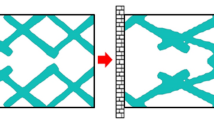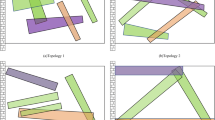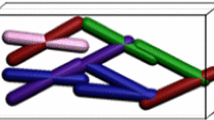Abstract
In this article, an explicit topology optimization approach with components-growing ability is proposed under the moving morphable component (MMC) framework. In this approach, the shape and topology layout of structures are explicitly optimized by growth evolution of moving morphable components. To this end, a competition criterion is developed to optimize the structural layout from two options: adding several new components or changing the current layout. In addition, some numerical technqiues are also developed to preserve the stability of the iterative process. The present topology optimization approach allows rational generation of new components and does not require a specific distribution of components in the initial design, which is compulsory for the conventional MMC method. Three numerical examples are provided to illustrate the effectiveness of the proposed method. The optimization results indicate that the proposed method does have the potential to improve the existing MMC-based explicit topology optimization framework by eliminating the initial design dependency of optimal solutions.
















Similar content being viewed by others
References
Bendsøe MP, Kikuchi N. Generating optimal topologies in structural design using a homogenization method. Comput Methods Appl Mech Eng. 1988;71(2):197–224.
Rozvany GI. A critical review of established methods of structural topology optimization. Struct Multidiscip Optim. 2008;37(3):217–37.
Guo X, Cheng G. Recent development in structural design and optimization. Acta Mech Sinica. 2010;26(6):807–23.
Deaton JD, Grandhi RV. A survey of structural and multidisciplinary continuum topology optimization: post 2000. Struct Multidiscip Optim. 2013;49(1):1–38.
Sigmund O, Maute K. Topology optimization approaches. Struct Multidiscip Optim. 2013;48(6):1031–55.
Sigmund O. On the design of compliant mechanisms using topology optimization. Mech Struct Mach. 1997;25(4):493–524.
Du Y, Yan S, Zhang Y, Xie H, Tian Q. A modified interpolation approach for topology optimization. Acta Mech Solida Sinica. 2015;28(4):420–30.
Wang MY, Wang X, Guo D. A level set method for structural topology optimization. Comput Methods Appl Mech Eng. 2003;192(1–2):227–46.
Barrera JL, Geiss MJ, Maute K. Hole seeding in level set topology optimization via density fields. Struct Multidiscip Optim. 2020;61(4):1319–43.
Wang SY, Lim KM, Khoo BC, Wang MY. On hole nucleation in topology optimization using the level set methods. CMES Comput Model Eng Sci. 2007;21(3):219–38.
Villanueva CH, Maute K. Density and level set-XFEM schemes for topology optimization of 3-D structures. Comput Mech. 2014;54(1):133–50.
Guo X, Zhang W, Zhong W. Doing topology optimization explicitly and geometrically—A new moving morphable components based framework. J Appl Mech. 2014;81(8):081009.
Guo X, Zhang W, Zhang J, Yuan J. Explicit structural topology optimization based on moving morphable components (MMC) with curved skeletons. Comput Methods Appl Mech Eng. 2016;310:711–48.
Bai J, Zuo W. Hollow structural design in topology optimization via moving morphable component method. Struct Multidiscip Optim. 2019;61(1):187–205.
Zheng S, Tang WH, Li BT. A new topology optimization framework for stiffness design of beam structures based on the transformable triangular mesh algorithm. Thin-Walled Struct. 2020;154:106831.
Eschenauer HA, Kobelev VV, Schumacher A. Bubble method for topology and shape optimization of structures. Struct Optim. 1994;8(1):42–51.
Novotny AA, Feijóo RA, Taroco E, Padra C. Topological sensitivity analysis. Comput Methods Appl Mech Eng. 2003;192(7–8):803–29.
Nazarov SA, Sokołowski J. Asymptotic analysis of shape functionals. J de Mathématiques Pures et Appliquées. 2003;82(2):125–96.
Lee S, Kwak BM. Smooth boundary topology optimization for eigenvalue performance and its application to the design of a flexural stage. Eng Optim. 2008;40(3):271–85.
Norato JA, Bendse MP, Haber RB, Tortorelli DA. A topological derivative method for topology optimization. Struct Multidiscip Optim. 2007;33(4):375–86.
Dunning PD, Alicia Kim H. A new hole insertion method for level set based structural topology optimization. Int J Numer Methods Eng. 2013;93(1):118–34.
Cai SY, Zhang WH. An adaptive bubble method for structural shape and topology optimization. Comput Methods Appl Mech Eng. 2020;360:112778.
Hou W, Gai Y, Zhu X, Wang X, Zhao C, Xu L, Jiang K, Hu P. Explicit isogeometric topology optimization using moving morphable components. Comput Methods Appl Mech Eng. 2017;326:694–712.
Sun J, Tian Q, Hu H, Pedersen NL. Topology optimization for eigenfrequencies of a rotating thin plate via moving morphable components. J Sound Vib. 2019;448:83–107.
Takalloozadeh M, Yoon GH. Implementation of topological derivative in the moving morphable components approach. Finite Elements Anal Design. 2017;134:16–26.
Du Z, Chen H, Huang G. Optimal quantum valley Hall insulators by rationally engineering Berry curvature and band structure. J Mech Phys Solids. 2020;135:103784.
Xie X, Wang S, Xu M, Wang Y. A new isogeometric topology optimization using moving morphable components based on R-functions and collocation schemes. Comput Methods Appl Mech Eng. 2018;339:61–90.
Yu M, Ruan S, Wang X, Li Z, Shen C. Topology optimization of thermal-fluid problem using the MMC-based approach. Struct Multidiscip Optim. 2019;60(1):151–65.
Zhang W, Yuan J, Zhang J, Guo X. A new topology optimization approach based on Moving Morphable Components (MMC) and the ersatz material model. Struct Multidiscip Optim. 2016;53(6):1243–60.
Zhu B, Chen Q, Wang R, Zhang X. Structural topology optimization using a moving morphable component-based method considering geometrical nonlinearity. J Mech Design. 2018;140(8):081403.
Mura T. Micromechanics of defects in solids. Distributors for the U.S. and Canada: Kluwer Academic Publishers; 1987.
Liu C, Zhu Y, Sun Z, Li D, Du Z, Zhang W, Guo X. An efficient moving morphable component (MMC)-based approach for multi-resolution topology optimization. Struct Multidiscip Optim. 2018;58(6):2455–79.
Zhang W, Zhang J, Guo X. Lagrangian description based topology optimization—A revival of shape optimization. J Appl Mech. 2016;83(4):041010.
Acknowledgements
The authors are grateful for the financial supports from the Foundation for Innovative Research Groups of the National Natural Science Foundation of China (Grant No. 11821202), the National Natural Science Foundation of China (Grant Nos. 11872138, 11702048, 11732004, 11772076 and 12002073), the 111 Project (Grant No. B14013), the Young Elite Scientists Sponsorship Program by CAST (Grant No. 2018QNRC001), the Fundamental Research Funds for the Central Universities, China (DUT20RC(3)020, DUT21RC(3)076) and Dalian Talent Innovation Program (2020RQ099).
Author information
Authors and Affiliations
Corresponding authors
Ethics declarations
Conflict of interest
The authors declare they have no conflict of interest.
Rights and permissions
About this article
Cite this article
Cui, T., Du, Z., Liu, C. et al. Explicit Topology Optimization with Moving Morphable Component (MMC) Introduction Mechanism. Acta Mech. Solida Sin. 35, 384–408 (2022). https://doi.org/10.1007/s10338-021-00308-x
Received:
Revised:
Accepted:
Published:
Issue Date:
DOI: https://doi.org/10.1007/s10338-021-00308-x




